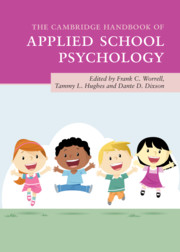Book contents
- The Cambridge Handbook of Applied School Psychology
- The Cambridge Handbook of Applied School Psychology
- Copyright page
- Contents
- Contributors
- Contributor Biographies
- Acknowledgments
- 1 Broadening the Focus of School Psychology Practice
- Part I Individual-Level Academic Interventions
- Part II Teacher- and System-Level Interventions
- 6 School-Based Interventions
- 7 Helping Teachers Use Progress Monitoring Data for Intervention Decisions
- 8 Supporting Teachers in Tier 1 Instruction: Use of Coaching and Formative Assessment
- 9 The Academic Support Index: A Tool for Contextualizing Student Data
- Part III Interventions from Educational and Social/Personality Psychology
- Part IV Behavioral and Social-Emotional Interventions
- Part V Health and Pediatric Interventions
- Part VI Family Connections and Life Transitions
- Part VII Special Populations
- Part VIII Conclusion
- Index
- References
9 - The Academic Support Index: A Tool for Contextualizing Student Data
from Part II - Teacher- and System-Level Interventions
Published online by Cambridge University Press: 18 September 2020
- The Cambridge Handbook of Applied School Psychology
- The Cambridge Handbook of Applied School Psychology
- Copyright page
- Contents
- Contributors
- Contributor Biographies
- Acknowledgments
- 1 Broadening the Focus of School Psychology Practice
- Part I Individual-Level Academic Interventions
- Part II Teacher- and System-Level Interventions
- 6 School-Based Interventions
- 7 Helping Teachers Use Progress Monitoring Data for Intervention Decisions
- 8 Supporting Teachers in Tier 1 Instruction: Use of Coaching and Formative Assessment
- 9 The Academic Support Index: A Tool for Contextualizing Student Data
- Part III Interventions from Educational and Social/Personality Psychology
- Part IV Behavioral and Social-Emotional Interventions
- Part V Health and Pediatric Interventions
- Part VI Family Connections and Life Transitions
- Part VII Special Populations
- Part VIII Conclusion
- Index
- References
Summary
The common practice of disaggregating student data by singular demographic fields such as race, English learner, or disability status can lead to flawed conclusions or reinforce harmful stereotypes. The Academic Support Index (ASI) provides an alternative lens for looking at student data by considering the interaction of seven common demographic fields and their relationship to academic achievement. The ASI has a strong association with outcomes including standardized assessments, grade point average, and postsecondary outcomes. This chapter will provide a history of the development of the ASI and its statistical foundation. Additionally, examples of how the ASI has been used to analyze data, identify students for support, design interventions, and evaluate programs are provided. The ASI has the potential to be an important tool in addressing both achievement and opportunity gaps.
Keywords
- Type
- Chapter
- Information
- The Cambridge Handbook of Applied School Psychology , pp. 138 - 154Publisher: Cambridge University PressPrint publication year: 2020

